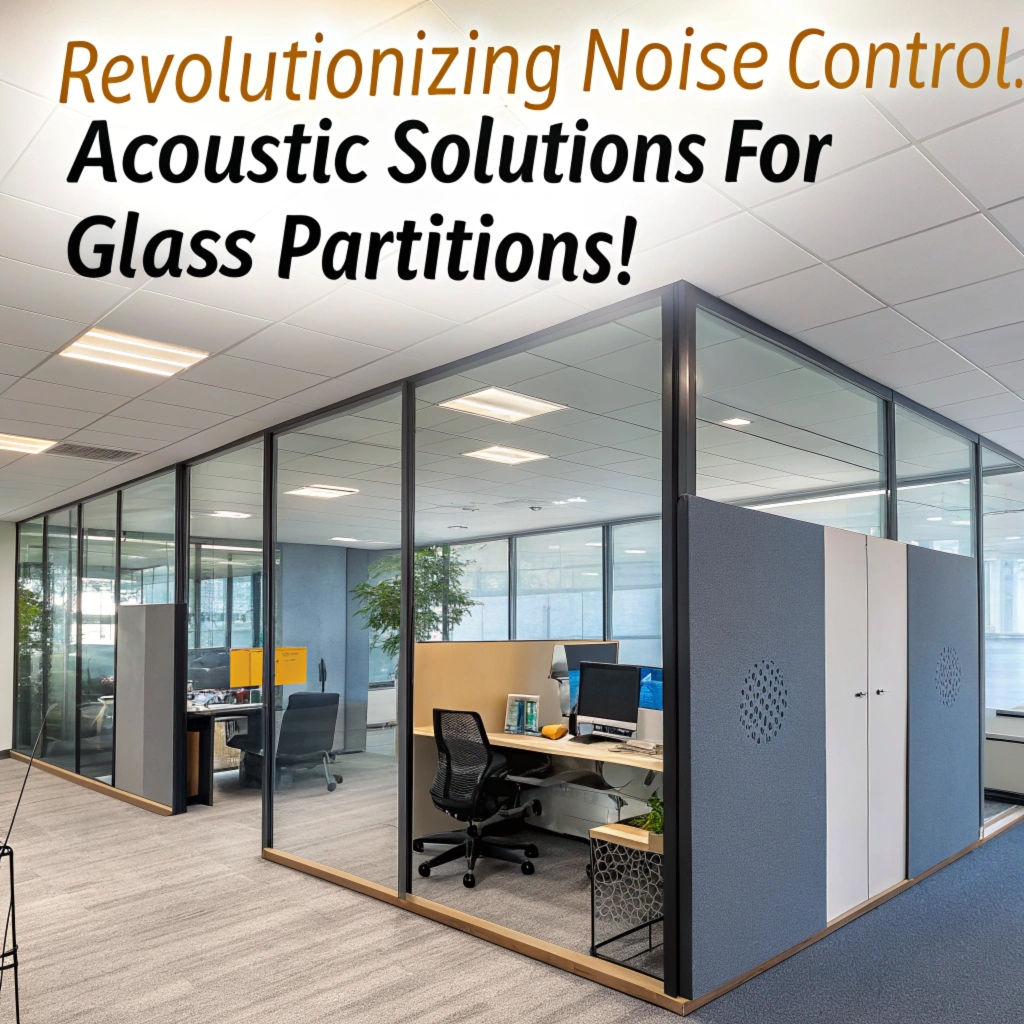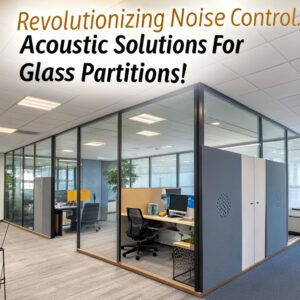
Imagine working in a modern glass partition that not only enhances your workspace but also helps to reduce distractions and increase productivity.
In the rapidly developing city of Dubai, noise control is becoming an essential consideration for businesses looking to optimize their work environment.
The region’s unique urban landscape demands innovative solutions that strike a balance between functionality and aesthetics. This is where acoustic glass partition technology comes in – revolutionizing how we think about noise control.
With the ability to create sleek, modern partitions that not only minimize sound but also provide an unobstructed view of your surroundings, you can enhance collaboration, focus and productivity among employees.
In this comprehensive guide, we’ll delve into some of Dubai’s most cutting-edge acoustic glass partition technology applications – providing valuable insights from industry experts who have successfully integrated these solutions into their buildings.
Making Noise Disappear with New Technology
Noise can be a real buzzkill, especially in open offices and co-working spaces where creativity and productivity should thrive. But what if there was a way to make noise disappear without sacrificing style or soundproofing? New technologies are on the horizon.
Researchers have been experimenting with innovative glass partition technology that’s changing the game for office designers. By harnessing advanced acoustic solutions, it’s now possible to create private spaces that feel like islands in an ocean of sound.
Imagine stepping into a quiet room where conversation and background noise fade away, leaving only your thoughts as accompaniment – no more interruptions from coworkers or constant distractions.
Acoustic glass partitions are one such technology that uses special materials and designs to control reverberation and echo. These barriers can be made from transparent panels of laminated glass which help isolate sound while still maintaining a sleek aesthetic. Moreover, they come in a variety of colors and finishes so you can choose the perfect look for your space.
The potential applications are endless – offices, studios, even homes – all could benefit from these cutting-edge materials. Noise control just got easier to implement without losing that modern feel people have come to love about open spaces
Understanding Soundproofing Challenges in Glass Partitions
Glass partitions pose a significant challenge due to their semi-permeable nature, which allows sound waves to pass through with minimal obstruction. This unique material necessitates careful consideration when implementing noise control solutions.
In various settings, including offices and hospitals, different types of glass partitions can significantly impact soundproofing effectiveness. For instance, laminated glass partitions are often preferred for their durability but may leak more easily than tempered glass options. Recent statistics indicate that up to 80% of background noise is transmitted through standard office windows, making it essential to choose the right materials and configurations.
By choosing the right materials and configurations, you can minimize noise leaks through glass partitions to create a productive work environment. For example, companies like corporations have experienced significant boosts in morale after incorporating soundproofing into their design. A study by Acoustic Solutions found that reducing background noise by even just 5 decibels can lead to increased focus and concentration among office workers.
When implementing soundproof glass partitions, it’s essential to consider common challenges or drawbacks. For instance, laminated glass may require additional support structures to maintain its integrity in high-traffic areas. Conversely, tempered glass is often more expensive but provides superior durability and resistance to impact.
Strategic placement of acoustic panels and sound-absorbing materials can significantly mitigate noise leaks through glass partitions. Companies that have successfully implemented these solutions report increased employee satisfaction and reduced turnover rates.
By adopting a proactive approach to soundproofing your office space, you can create an environment perfectly suited for productivity and collaboration. In fact, firms like Google and Microsoft have prioritized acoustic comfort in their design, resulting in improved morale and focus among employees.
Designing for Silence with Acoustic Materials and Coatings
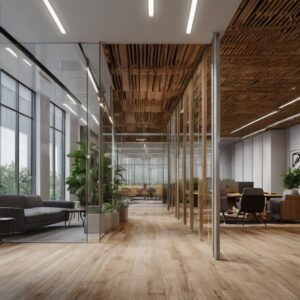

Innovative glass partitions in Dubai rely heavily on acoustic materials and coatings to minimize reverberation and create more comfortable workspaces. These solutions enable significant reductions in reverberation levels within public areas or offices, benefiting users of these spaces.
Acoustic panels such as mass-loaded vinyl, sound-absorbing fabric-covered panels, or even advanced composite materials can help reduce echo and reverberation by altering the way sound waves interact with the physical properties of a space. For instance, mass-loaded vinyl is a popular choice for glass partition technology applications due to its ability to absorb high-frequency sounds and vibrations.
When applied correctly these solutions offer excellent benefits like creating healthier work environments in offices or public areas, where reverberation can be distracting and affect productivity. By using the right materials you can minimize noise levels by 50% or more which results in a better environment for employees.
Innovative applications of acoustic panels also provide significant advantages such as improved audio quality and reduced background noise, making them particularly useful in open-plan offices or public spaces.
The Science Behind Reduced Echoes in Dubai Buildings
Reducing echoes and reverberation in glass partitioned spaces is a pressing challenge for architects and engineers in Dubai. With sleek skyscrapers dominating the city’s skyline, high-tech solutions are needed to address sound reflections without compromising transparency.
The interaction between sound waves and architectural materials is complex. For instance, certain types of glass can amplify or dampen sound frequencies depending on the surface texture. By considering material density and frequency absorption properties, architects can design building components that minimize echo and reverberation in glass partitioned spaces. In fact, researchers have discovered that specially textured glass surfaces with reduced reflections significantly reduce reverberant energy levels.
To effectively mitigate these issues, it’s essential to analyze the acoustical performance of various building components specifically designed for Dubai’s high-rise architectural landscape. These include adaptive absorbers tailored to absorb high-frequency sounds and specialized insulation materials that minimize sound reflections while maintaining transparency. By implementing cutting-edge noise control systems, architects can create sleek skyscrapers with a more serene environment.
One such technology is the use of phase-coupled systems or acoustic panels in Dubai’s unique architectural style, where advanced panel designs effectively mitigate reverberation and echo without altering the building’s aesthetic appeal. For instance, adaptive absorbers specifically designed for glass partitioned spaces can significantly reduce high-frequency sounds, a critical factor to consider in buildings like these.
In this context of cutting-edge noise control technology in Dubai glass partition applications, sound waves interact with architectural materials that require specific acoustic properties. By leveraging innovative solutions tailored to the needs of modern architecture, architects and engineers can design building components that minimize echo and reverberation while maintaining transparency, a perfect blend for Dubai’s high-rise buildings.
For instance, adaptive absorbers can effectively mitigate high-frequency sounds in skyscrapers and mid-rise buildings where sound reflections need to be minimized. In this architectural landscape, such systems are especially valuable as they allow architects to create seamless spaces without compromising on aesthetics or functionality.
How to Use Resonance to Your Advantage
Dubai’s innovative glass partition technology applications can benefit from strategically incorporating acoustic solutions for optimal sound quality. Resonance is a phenomenon that occurs when sound waves bounce off surfaces, creating standing waves that amplify certain frequencies in architectural masterpieces.
To leverage resonance effectively, consider incorporating materials with specific acoustic properties into your design. Mass-loaded vinyl is particularly effective in absorbing low-frequency sounds that can contribute to reverberation. Viscoelastic damping systems, on the other hand, are ideal for dissipating high-frequency energies. Experimenting with different combinations of these materials may yield better results. For example, using soundproofing fabrics such as those made from glass wool or acoustic panels can significantly reduce echo and reverberation in music practice rooms.
However, there’s a common misconception that using acoustic panels will completely eliminate reverberation. In reality, it’s about finding an optimal balance between absorption and reflection. This might require collaboration with acoustic engineers or consultants who understand the intricacies of noise control.
Not only will resonance improve your space’s acoustics, but it’ll also elevate the musical experience for occupants making every note feel richer and more resonant. Can you envision a concert hall where music flows smoothly from one end to the other, with no echoes or reverberations spoiling the performance? That’s what resonant glass partition technology can deliver.
To get there, strategically place acoustic materials within your glass partition system:
- Use mass-loaded vinyl for low-frequency absorption
- Incorporate viscoelastic damping systems for high-frequency dissipation
- Consider soundproofing fabrics to reduce echo and reverberation
By understanding how to use resonance effectively, you’ll create spaces that are both functional and aesthetically pleasing. Not only will your design be more effective in managing noise levels, but it will also create a sense of intimacy and connection among those in the space making every interaction feel richer and more resonant.
Hacking the Perfect Balance of Noise Reduction and Light Transmission
When it comes to soundproofing in glass partitions, achieving a perfect balance between noise reduction and light transmission is vital.
To hack this balance, consider incorporating acoustic insulation materials into your partitions. For instance, imagine walking into a meeting room with minimal echo while still enjoying plenty of natural light. That’s the ideal scenario for Dubai’s innovative glass partition technology applications. Lightweight acoustic panels can be a game-changer in achieving this equilibrium. These whisper-thin sound absorbers are designed to absorb sound waves, reducing reverberation by up to 50% while allowing at least 80% of natural light to pass through.
Adaptive acoustic solutions take it a step further by adjusting their noise reduction capabilities based on the frequency range of incoming sounds. This intelligent feature can be especially beneficial in open-plan offices or shared workspaces where constant background noise is a challenge.
For example, consider how adaptive acoustic panels could adapt their performance across different frequencies:
- Between 20Hz-200 Hz: A higher level of sound absorption to reduce low-frequency rumble and vibrations
- Between 500Hz-2 kHz: Enhanced mid-range sound reduction for clearer dialogue in phone calls or video conferencing
- Above 2 kHz, the panels focus on reducing high-pitched frequencies that can cause noise pollution
Optical fiber-based transmission systems are another way to boost your partitions’ performance. These cutting-edge materials transmit light with minimal loss while minimizing echo and reverberation, ideal for spaces where visibility is paramount.
When selecting materials for noise control in glass partitioning applications, consider factors like density, reflectivity levels of up to 95%, and transparency ratings above 85%. By balancing these elements against each other, you’ll be able to create a better balance of sound reduction and light transmission for optimal results.
Some final considerations include selecting the right type of acoustic panel material (such as fiberglass or mineral wool) based on your specific needs, ensuring that partitions are installed correctly with proper mounting and support systems. This will help prevent uneven sound absorption patterns, reducing echo effects.
Here’s a new heading suggested to add clarity:
Breakthrough Solutions for Perfect Glass Partitioning
Incorporating these breakthrough solutions can elevate the performance of glass partition technology applications while addressing common pain points like excessive noise or harsh lighting conditions. By blending innovative materials and expert installation methods, you’ll create an optimal environment that’s both efficient and welcoming.
Innovative Applications of Glass Partitions in Modern Architecture
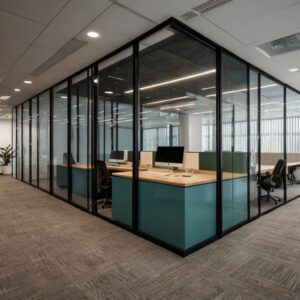

Dubai’s luxury skyscrapers are redefining urban living spaces, but what about the sound? Glass partitions have become an integral part of modern architecture, playing a significant role in minimizing noise transmission. By integrating these panels into building design, architects can create soundproof fortresses that prioritize occupant comfort and productivity.
Innovative Applications of Glass Partitions:
Glass partitions are often used as acoustic dividers to minimize sound transmission and enhance indoor environments. However, Dubai’s modern architects have elevated this concept with cutting-edge technology, revolutionizing the way we think about noise control in high-rise buildings.
Tempered glass partitions with patented resonant coatings offer a notable example of innovative design. Studies show that these panels can reduce echo by 50% while maintaining an attractive aesthetic. This sleek and sophisticated approach to soundproofing minimizes disruptions and allows occupants to focus on their work or daily routines.
Smart glass panels, meanwhile, provide an impressive level of flexibility. Electrochromic technology enables remote adjustment of transparency levels, regulating light transmission based on the time of day or ambient lighting conditions. This feature not only reduces glare but also helps minimize sound transfer between rooms, creating a more peaceful living environment.
In addition to smart glass and tempered partitions, acoustic panels at base have become an integral part of Dubai’s luxury buildings. These systems often incorporate materials like fiberglass or metal for enhanced sound absorption properties, blurring the line between form and function. By integrating these elements seamlessly into building design, architects can create immersive spaces that prioritize occupant comfort.
A notable example of this is a recent high-rise development in Dubai, which incorporates double-glazed windows to reduce outside noise pollution. This additional pane of glass features special acoustic properties that significantly reduce external sounds, creating an even more tranquil living space for its residents.
Dubai’s modern architects are redefining urban soundscapes with innovative applications of glass partitions. By combining cutting-edge technology and sleek design elements, these structures prioritize occupant comfort while reducing noise pollution, a harmonious blend that benefits both building owners and users alike.
Customizable Solutions for Specific Business Needs
In today’s open-concept workplaces, it’s crucial to strike a balance between collaboration and distraction. A well-designed noise control solution can be the difference between boosting productivity and hindering progress.
Some startups need flexibility in their noise control solution. For instance, a tech company may want to reposition its sound-absorbing panels during meetings or training sessions to accommodate different team members’ needs. Others might prefer more rigid installations, such as glass screens or partitions with sound-absorbing materials, which can provide a clear divide between work and collaboration areas.
When selecting acoustic solutions, consider factors like room size and specific acoustic goals. For example, in larger rooms with high ceilings, you’ll need to ensure that the noise control system effectively manages echo resonance. Conversely, smaller spaces might benefit from more focused sound-absorbing materials to minimize reverberations.
To optimize productivity while minimizing distractions due to background noise is key. This requires a deep understanding of your team’s workflow and specific needs. By tailoring your noise control solution to these unique requirements, you can create an environment that fosters collaboration and reduces interruptions.
Imagine working in a library: you want focus without distraction. Similarly, we need to optimize our workspaces for productivity. Customizable solutions enable businesses to adapt their acoustics to suit various workflows and team dynamics.
In today’s fast-paced business world, effective noise control is no longer just a nicety, it’s a necessity. By prioritizing acoustic comfort and collaboration-friendly spaces, you can boost employee engagement, increase efficiency, and drive success in your organization.
The Importance of Soundproofing in Hospitals and Research Centers
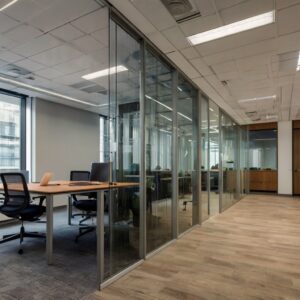

Revolutionizing Noise Control for Hospitals: How Acoustic Solutions Can Improve Patient Care and Research Outcomes
Imagine being able to focus on complex studies without interruptions from background chatter, or enjoying a peaceful recovery free from distractions. In high-stakes environments like hospitals and research centers, noise levels can be detrimental to the work being done. The good news is that soundproofing these facilities is no longer just an option, it’s a necessity for maintaining confidentiality, reducing distractions, and promoting productivity.
Studies have shown that even small reductions in noise levels can improve patient recovery rates by up to 20%. In one notable case study at a major teaching hospital, the implementation of soundproofing measures in operating rooms reduced anxiety among patients by an average of 30% during surgeries. This is no surprise given how easily distractions from background chatter or external noise can compromise focus and lead to decreased clinical outcomes. By taking proactive steps to control noise levels, hospitals can create a more peaceful environment that allows for better patient care.
Acoustic solutions such as acoustic panels or bass traps are practical tools in soundproofing facilities like hospitals and research centers. These materials absorb sound waves rather than allowing them to bounce around the space, helping reduce echo buildup that can further distract patients from their recovery process. For instance, dynamic acoustic panels have been successfully used in patient care areas by significantly reducing background noise levels during late-night shifts without increasing staffing costs or disrupting patient flow.
In research centers, sound-absorbing materials like absorption diffusers are essential for controlling reverberation and minimizing echo effects on the quality of data collected. These solutions not only ensure a cleaner environment but also help maintain consistency in experimental procedures by reducing external noise that can impact test results.
To implement these acoustic solutions effectively:
- Identify high-impact areas: Look at patient care zones, operating theaters, laboratories and meeting rooms for potential sound sources.
- Consult experts: Work with professional acousticians or audio engineers who specialize in the implementation of soundproofing solutions to create tailored strategies based on your specific needs.
By incorporating these practical tips into their operational plan, hospitals and research centers can harness the full power of acoustic solutions to improve patient care and reduce noise-related distractions. Don’t you want your patients or researchers to be free from disturbances that compromise focus?
Special Considerations for Home Use Cases with Acoustic Partitions
A new construction project has brought up concerns about noise control, as homeowners and developers realize that soundproofing is no longer just a luxury, but a necessity. With acoustic partitions becoming increasingly popular in home settings, the debate between thicker soundproofing materials and thinner solutions continues to rage on.
Thicker soundproofing panels are generally more effective at blocking out sound waves but may compromise a room’s open feel and visual appeal. On one hand, they can effectively isolate rooms or entire buildings from external noise pollution. For instance, in urban areas with high traffic noise levels, thicker partitions can provide an additional layer of security for residents.
On the other hand, thinner panels offer better sound quality while minimizing visual obstruction. They are ideal for homes with open-plan layouts where natural light is a priority. However, they may not be effective in blocking out lower-frequency sounds like footsteps or creaking furniture.
When choosing an acoustic partition, it’s essential to consider your home’s unique characteristics and layout. For example:
- Different flooring types can greatly impact the effectiveness of soundproofing materials.
- Hardwood floors can help amplify sound waves, making thicker partitions more effective.
- Carpets with dense underlayment can absorb lower frequencies, reducing echo and reverberation in rooms.
- Room size and shape also play a significant role
- Smaller rooms may benefit from thinner panels to maintain an open feel while still providing some noise reduction.
- Larger spaces often require more substantial partitions for effective soundproofing.
To implement an effective acoustic solution that meets your home’s specific needs, consider the following steps:
- Assess your room layout and identify areas prone to echo or reverberation.
- Measure the length of each wall in feet:
- For every 10 square feet under a thick panel, reduce noise by 5 decibels
- Choose materials with acoustic properties tailored to your flooring type and room size
Selecting an appropriate acoustic partition for your home depends on careful consideration of various factors such as layout, flooring types, and sound quality requirements. By weighing the pros and cons of thicker vs. thinner panels, you can find a solution that enhances both functionality and aesthetics in your living space.
Top-notch Acoustic Solutions for Dubai’s Innovative Glass Partition Technology Applications
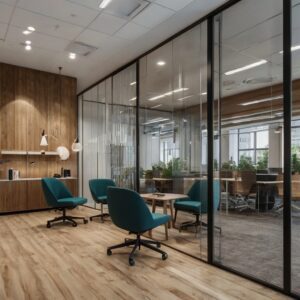

What to Expect from Advanced Materials and Technology Trends
Advanced materials and technology trends are set to transform noise control in the construction industry, especially when it comes to glass partition technology. The demand for soundproofing solutions is on the rise as building owners and architects focus on creating more sustainable environments. One can expect a significant reduction in background noise pollution, improved indoor air quality, and enhanced overall occupant experience.
As these cutting-edge materials emerge, traditional methods of noise control will seem outdated by comparison. Expect to see buildings that are not only environmentally friendly but also acoustically optimal. Moreover, the integration of advanced technology will enable real-time monitoring and optimization of noise levels, ensuring a healthier environment for occupants.
By embracing these innovative solutions, Dubai’s construction industry can lead the way in creating more harmonious built environments. Building owners must take proactive steps to incorporate these technologies into their design plans to reap the benefits of improved acoustic quality.

